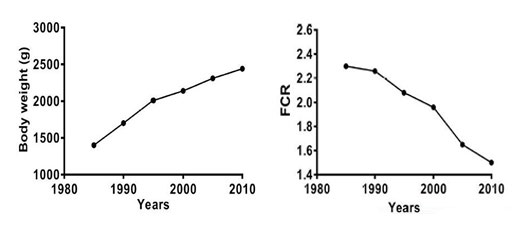1.Economic and Social Development Department. World Agriculture towards 2030/2050. Available at: http://www.fao.org/ economic/esa/esag/esag- home/en/ 2003; Accessed 2015.
2.Alley RB, Clark PU, Huybrechts P, Joughin I. Ice-sheet and sea-level changes. Science. 2005; 310: 456-460. doi: 10.1126/ science.1114613
3. St-Pierre NR, Cobanov B, Schnitkey G. Economic losses from heat stress by US livestock industries. J Dairy Sci. 2003; 86: E52-E77. doi: 10.3168/jds.S0022-0302(03)74040-5
4. Mora C, Frazier AG, Longman RJ, et al. The projected timing of climate departure from recent variability. Nature. 2013; 502: 183-187. doi: 10.1038/nature12540
5. Willems OW, Miller SP, Wood BJ. Aspects of selection for feed efficiency in meat producing poultry. Worlds Poult Sci J. 2013; 69: 77-88. doi: 10.1017/S004393391300007X
6. Aggrey SE, Karnuah AB, Sebastian B, Anthony NB. Genetic properties of feed efficiency parameters in meat-type chickens. Genet Sel Evol. 2010; 42: 25. doi: 10.1186/1297-9686-42-25
7. Siegel PB. Evolution of the modern broiler and feed efficiency. Annu Rev anim Biosci. 2014; 2: 375-385. doi: 10.1146/ annurev-animal-022513-114132
8. Valles A, Marti O, Garcia A, Armario A. Single exposure to stressors causes long-lasting, stress-dependent reduction of food intake in rats. Am J Physiol Regul Integr Comp Physiol. 2000; 279: R1138-R1144.
9.Satterlee DG, Johnson WA. Selection of Japanese quail for contrasting blood corticosterone response to immobilization. Poult Sci. 1988; 67: 25-32. doi: 10.3382/ps.0670025
10.Sawchenko PE. Toward a new neurobiology of energy balance, appetite, and obesity: The anatomists weigh in. J Comp Neurol. 1998; 402: 435-441. doi: 10.1002/(SICI)1096-9861 (19981228)402:4<_x0034_35:_x003a_AID-CNE1>3.0.CO;2-M
11.Bordas A, Merat P. Genetic variation and phenotypic correlations of food consumption of laying hens corrected for body weight and production. Br Poult Sci. 1981; 22: 25-33. doi: 10.1080/00071688108447860
12. Sintubin P, Greene E, Collin A, et al. Expression profile of hypothalamic neuropeptides in chicken lines selected for high or low residual feed intake. Neuropeptides. 2014; 8: 213-220. doi: 10.1016/j.npep.2014.04.007
13.Raimbault S, Dridi S, Denjean F, et al. An uncoupling protein homologue putatively involved in facultative muscle thermogenesis in birds. Biochem J. 2001; 353: 441-444
14.Bottje W, Iqbal M, Tang ZX, et al. Association of mitochondrial function with feed efficiency within a single genetic line of male broilers. Poult Sci. 2002; 81: 546-555. doi: 10.1093/ ps/81.4.546
15.Lassiter K, Greene E, Piekarski A, et al. Orexin system is expressed in avian muscle cells and regulates mitochondrial dynamics. Am J Physiol Regul Integr Comp Physiol. 2015; 308: R173-R187. doi: 10.1152/ajpregu.00394.2014






